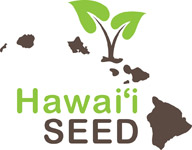-
Papaya production taking a tumble
Posted on March 19, 2006 by Hawai'i SEED in Agriculture, NewsBy Sean Hao
Advertiser Staff Writer
Honolulu Advertiser
March 19, 2006
Hawai’i papaya production sank to a more than 25-year low last year despite record demand among U.S. consumers for the tropical fruit.
Americans on average now eat 1 pound of papaya annually, which is up from less than one-third of a pound just 10 years ago. That should bode well for growers of Hawai’i’s second largest fruit crop. However, last year papaya production fell 17 percent to 28.5 million pounds, the smallest crop since before 1980. Sales dipped 14 percent to $10.6 million, the lowest amount since 1985.
Imports from countries such as Mexico and Brazil are helping to fill America’s increasing appetite for papaya.
Hawai’i’s papaya farmers, as with most farmers on the Islands, are dealing with a long list of challenges, including foreign competition, high costs, fickle weather, insects and disease.
“Plenty of people are not growing papaya anymore,” said Alberto Belmes, who grows papaya on about 70 acres of land seven miles outside of Hilo. “The price is going down and still the costs of farming goes up.”
Unlike most other Hawai’i farmers, papaya growers have one other issue with which to deal. Many Hawai’i papaya growers are raising a genetically engineered product that has yet to generate the market acceptance and higher sales prices that non-genetically modified papayas command. Japan, for example, does not accept genetically modified papaya.
Papaya growers elsewhere are not using the genetically modified product.
Developed in part by the University of Hawai’i, the genetically modified papaya was designed to be resistant to ring spot virus, which results in fewer and lower quality fruit.
The virus was first detected in 1992 on the Big Island, where the bulk of papayas are grown. The genetically modified papaya was introduced in 1998. Papaya production picked up that year and for the following three years. In 2002, production resumed its slide and has declined each year since.
Genetically modified papaya proponents argue that there would be no papaya industry if not for the new variety. They also point out that the widespread use of genetically modified papaya helps control the virus, so non-genetically modified papaya can be grown virus-free.
“I’ve seen the (Big Island papaya) industry go down from the first day it was infected in 1992,” said Dennis Gonsalves, an inventor of the genetically modified papaya and director for the USDA Pacific Basin Agricultural Research Center in Hilo. “If you kept the situation like that the curve would have gone down until it was no longer feasible to grow.”
Environmentalists and other critics contend the virus could have been managed in part by reducing the size of plantings and by diversifying the types of plants grown at any one time. While the genetically modified papaya may reduce problems with the ring spot virus, it introduced other problems by raising the risk of cross-pollination with non-genetically modified and organic papayas. Proponents contend the risks of cross-pollination are manageable.
Nevertheless, the use of genetically modified papaya in Hawai’i results in a more rigorous testing regime for non-modified papaya to maintain exports to markets that don’t accept genetically modified papayas, said Melanie Bondera, a board member for Hawaii Seed, an advocate for sustainable agriculture and a GMO-free Hawai’i.
The genetically modified papaya did not save the industry as its backers contend, Bondera said.
“They’re apparently not looking at the bigger picture of the economic problems that come with it — the cross-contamination, the market loss, the testing costs,” Bondera said. “Did we really have a problem that would have killed the industry if we did not have the GMO (genetically modified organism) papaya? That’s their contention. The bottom line is the GMO papaya has never sold for as much as the non-GMO papaya.”
Because Japan doesn’t allow imports of genetically modified papayas, Hawai’i exports of papaya to Japan fell from $10.3 million in 1998 to $4.6 million last year, according to the Foreign Trade Zone Division of the state Department of Business, Economic Development and Tourism. During that time, sales to the second largest importer of Hawai’i papayas — Canada, which accepts the genetically modified product — more than doubled to $2.6 million last year.
“In this sense you can say that the GMO is not any good, but you would not even have a market in Japan without GMO papaya,” said Gonsalves.
Canada, Hawai’i and the U.S. Mainland remain big buyers of genetically modified papayas. There are no requirements that genetically modified foods be labeled as such. In Hawai’i, the Kapoho variety of papaya is not genetically modified, while the Rainbow variant is.
With all the challenges facing papaya, the fruit’s rank among major Hawaiian crops is slipping. In 2004, algae, which is used as a nutritional supplement, displaced papaya as the state’s eighth largest commodity with sales of $12.6 million. Papaya was pushed down to ninth place with sales of $12.3 million.
State officials are still urging Japan to accept genetically modified papayas. Meanwhile, some people downplay the ban’s impact.
“We don’t have to get into Japan, if we can get into the U.S.,” said Stephanie Whalen, president of the the Hawaii Agriculture Research Center, which provides seeds for genetically modified papaya trees.
Hawai’i’s efforts to expand its share of the Mainland market for papaya has been hampered by several factors including difficulties establishing a genetically modified papaya seed production and payment program, Whalen added.
“The problem is we have small industries that are very difficult to organize,” she said. “There’s a whole education and learning process that has to grow and develop.”
Reach Sean Hao at shao@honoluluadvertiser.com.




